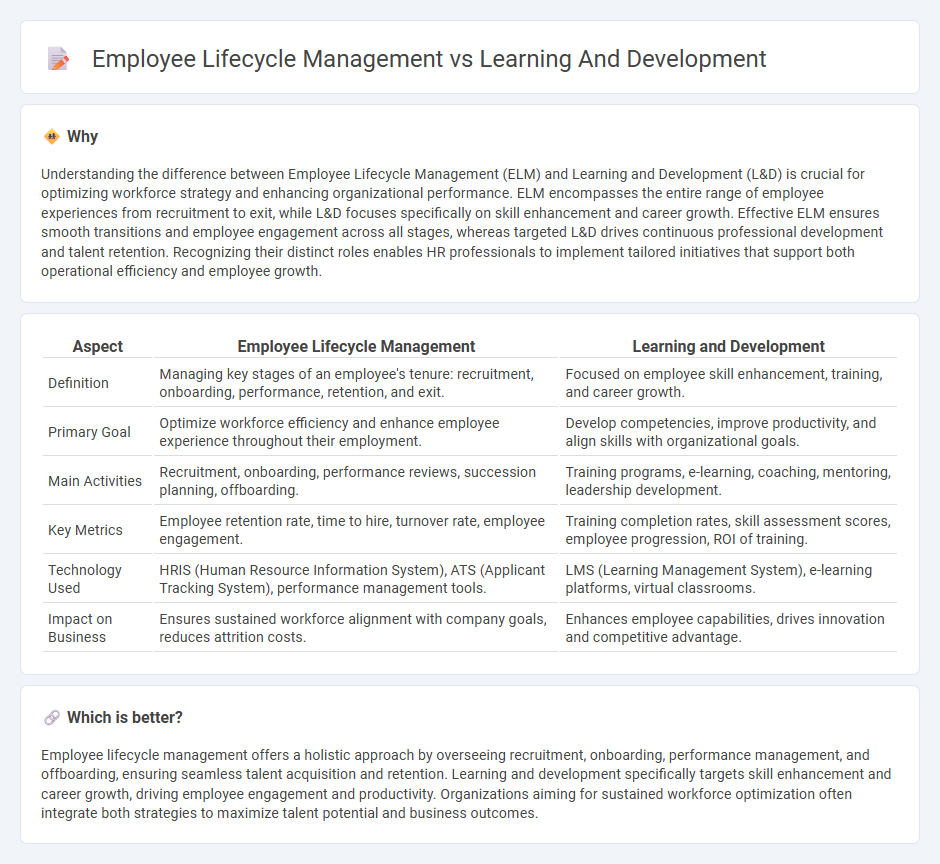
Human Resources encompasses crucial functions such as Employee Lifecycle Management and Learning and Development, both vital for organizational success. Employee Lifecycle Management oversees recruitment, onboarding, performance, and offboarding processes, ensuring seamless talent management. Explore how integrating these practices enhances workforce efficiency and growth.
Why it is important
Understanding the difference between Employee Lifecycle Management (ELM) and Learning and Development (L&D) is crucial for optimizing workforce strategy and enhancing organizational performance. ELM encompasses the entire range of employee experiences from recruitment to exit, while L&D focuses specifically on skill enhancement and career growth. Effective ELM ensures smooth transitions and employee engagement across all stages, whereas targeted L&D drives continuous professional development and talent retention. Recognizing their distinct roles enables HR professionals to implement tailored initiatives that support both operational efficiency and employee growth.
Comparison Table
| Aspect | Employee Lifecycle Management | Learning and Development |
|---|---|---|
| Definition | Managing key stages of an employee's tenure: recruitment, onboarding, performance, retention, and exit. | Focused on employee skill enhancement, training, and career growth. |
| Primary Goal | Optimize workforce efficiency and enhance employee experience throughout their employment. | Develop competencies, improve productivity, and align skills with organizational goals. |
| Main Activities | Recruitment, onboarding, performance reviews, succession planning, offboarding. | Training programs, e-learning, coaching, mentoring, leadership development. |
| Key Metrics | Employee retention rate, time to hire, turnover rate, employee engagement. | Training completion rates, skill assessment scores, employee progression, ROI of training. |
| Technology Used | HRIS (Human Resource Information System), ATS (Applicant Tracking System), performance management tools. | LMS (Learning Management System), e-learning platforms, virtual classrooms. |
| Impact on Business | Ensures sustained workforce alignment with company goals, reduces attrition costs. | Enhances employee capabilities, drives innovation and competitive advantage. |
Which is better?
Employee lifecycle management offers a holistic approach by overseeing recruitment, onboarding, performance management, and offboarding, ensuring seamless talent acquisition and retention. Learning and development specifically targets skill enhancement and career growth, driving employee engagement and productivity. Organizations aiming for sustained workforce optimization often integrate both strategies to maximize talent potential and business outcomes.
Connection
Employee lifecycle management integrates Learning and Development by aligning training programs with each phase of an employee's journey, from onboarding to career growth. Tailored learning initiatives enhance skill development, engagement, and retention throughout recruitment, performance management, and succession planning. This connection ensures organizational competency and supports continuous talent optimization within Human Resources strategies.
Key Terms
**Learning and Development:**
Learning and Development (L&D) centers on enhancing employee skills, knowledge, and competencies through targeted training programs and continuous professional growth initiatives. It plays a crucial role in boosting employee engagement, productivity, and retention by aligning individual development with organizational goals. Explore more to understand how effective L&D strategies drive sustainable business success.
Training
Learning and development concentrates on enhancing employee skills and competencies through continuous training programs, fostering professional growth and career advancement. Employee lifecycle management encompasses all phases of an employee's tenure, from recruitment to retention and offboarding, with training serving as a pivotal element in onboarding, performance improvement, and skill renewal. Explore how integrating targeted training within employee lifecycle management can optimize workforce potential and organizational success.
Upskilling
Learning and development centers on upskilling employees through targeted training programs that enhance professional growth and adapt to evolving industry demands. Employee lifecycle management integrates upskilling as a critical phase within talent acquisition, retention, and performance evaluation to ensure workforce agility and sustained business success. Discover how strategic upskilling bridges learning and development with comprehensive employee lifecycle management for optimized organizational impact.
Source and External Links
Learning and Development: A Comprehensive Guide - AIHR - Learning and development (L&D) is a systematic process to enhance employees' skills, knowledge, and competency, improving work performance, and is a core HR function essential for talent retention and employee engagement.
Learning and Development Importance [Updated 2025] - Kaltura - L&D aligns employee goals with organizational objectives by identifying skill gaps and delivering targeted training, managed by L&D teams who also optimize ROI and implement effective training technologies and strategies.
What is Learning and Development? - TD - L&D empowers employee growth through knowledge and skills development to drive business results and may include onboarding, leadership programs, career development, and compliance training as part of HR or business unit functions.
 dowidth.com
dowidth.com